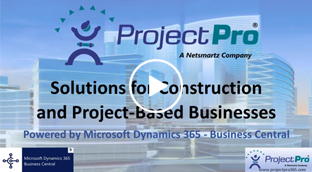Interaction with Paul Grace on Digital Trends in Construction
Digitalization is leaving its footprints in every industry and construction is not an exception in this regard. The least digitized sector is now shifting towards various digital technologies such as cloud computing, AI, AR & VR. This is because of the COVID-19 pandemic. It has pushed contractors to move beyond their limitations to achieve their goals and thrive in the market.
As per researchers, several construction companies have automated their workflows and operations for achieving better results. This time ProjectPro has interviewed Paul Grace, an industry expert to know his viewpoint on the recent technological advancements in the sector.
Who Did We Interview?
Paul Grace is the Head of Digital Marketing in a leading BIM Implementing Company. He is highly skilled and professional, influencing construction professionals globally. With decades of experience he has the ability to work in the demanding environments and deliver excellence.
Let Us Quickly Dive into Our Expert’s Point Of View
Question 1: In the age of COVID-19, how do you see the construction industry in the year 2022? Do you think this year will be a “digital year” for construction professionals?
The outbreak of the coronavirus affection and the posterior spread of the virus around the world has formerly construction market. Around the world, government blockades have shown that digital transformation on all aspects has become the lifeblood of modern society, especially the workforce.
This lesson was learned in the ongoing efforts of the construction industry professionals to diversify the economy and enjoy the benefits of digital transformation. Therefore, the answer is definitely! This year and the upcoming years will show a great move towards the digitalization of the construction industry and construction professionals.
Question 2: The construction industry has undergone dynamic changes over the years. What do you consider the biggest challenge for this industry now?
Whatever growth in the construction industry and especially for the digital transformation we can attribute to the pandemic, its economic damage could also derail progress. Firstly, the loss of jobs from an industry that is already struggling with acute unemployment will augment suffering and may slow the spread of connectivity. Furthermore, a credit crisis might follow as the IMF (International Monetary Fund) has warned.
As governments borrowed heavily from domestic banks to finance relief measures. Overexposure to government debt may crowd out financing that the private sector needs to recover and capitalize on the expansion of digital consumption.
To bolster the market’s growing digital economy, governments should work more closely with national stakeholders, the local private sector, and international organizations to realign regulations at the regional level to make it easier for companies to conduct business across multiple countries.
Furthermore, standardizing credentials and qualifications frameworks coupled with labor mobility policies will allow tech-savvy workers to move with the digital infrastructure and contribute to growth and connectivity.
Question 3: What potential do you see in the latest construction technology trends? Are they capable of boosting the productivity of construction professionals?
These challenges lead us to the three P’s which are the key to investment in digital transformation. Triple Ps are People, Process, and Platforms. according to Accenture and Industry X’s Principal Director, Stephen Pester. And though research from Accenture shows that 90 percent of companies in the construction industry are investing in digital transformation, more than 60 percent of them are not getting the results they were hoping to see.
Taking all the advantages of the 3 Ps into consideration, will lead to the digital revolution in the industry, as the digital revolution is highlighting the need for construction professionals to continue upskilling and reskilling for the future. Architects, for example, are increasingly using Virtual Reality (VR) in the planning and design stages of projects.
By having a 3D perspective of their work in the design phase, architects can push the boundaries and ultimately benefit from risk and cost reduction, and improved safety, quality, and accuracy. New technology allows architects to take risks, push the limits and achieve greatness both on projects and their personal development.
As the future of engineering in the market is bright, and digital is supporting the modernization of the disciplines. The rise of mega projects is paving way for exciting career opportunities for both graduate and professional engineers, inspiring them to use technology to drive innovation.
Question 4: Where do you see the construction industry in the next five years? Please share your valuable insights with our readers.
Overcoming the challenges and turning them into potential opportunities leads to sustainability of the product of the construction industry, as digital technologies can be used in construction to increase efficiencies from design phase to build out. BIM, for example, automates design tasks and is used to ensure data accuracy and establish intelligent modeling of infrastructure.
By using BIM in conjunction with advanced technology like aerial drones and augmented reality, architects and engineers can explore a variety of solutions to infrastructure design problems that would have been inconceivable just a few years ago.
Sustainability is the main driver for most of the recently constructed and established cities in the market, as it is envisioned to be a Net Zero, smart city by 2030. Smart technologies improve services for communities by enhancing their efficiency, safety, wellbeing, and access to information. This is not just about traditional engineering but about combining creative genius with innovation and technology to provide digital solutions for a better planet.
Get to Know Our Influencer
In this series of questions, Paul Grace shares a bit more about himself.
In four words or less, what’s your prediction about the transforming construction industry?
Automation, drones, and Digital Twins.
What’s your success mantra?
“A plan is what, a schedule is when. It takes both a plan and a schedule to get things done.” Peter Turla.
More Details
Paul Grace is highly skilled in leading cross-functional construction teams, liaising with contractors and external agencies, and ensuring on-time completion of project milestones. He is capable of working in demanding environments and introducing best practices.





